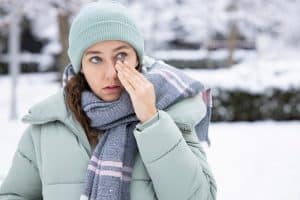Alongside winter comes a whole host of challenges, from poorer weather to colder temperatures and everything in between. Looking after yourself in the winter months is crucial, and in many cases, taking simple precautions can help to prevent discomfort and pain exacerbated by the season.
Below, we discuss how winter can make eye irritation worse, and what you can do to protect your eyes in the colder months.
What causes itchy eyes in winter?
Dry eye syndrome is a condition that causes sore, uncomfortable eyes, often paired with excessive tear production or blurry vision.[1] While it’s a condition that can affect anyone at any time of the year, research suggests that there may be a number of seasonal factors causing peaks in experiencing dry eye – largely centred around the winter and the spring.[2]
In the springtime, this peak in dry eye prevalence has been linked to high levels of pollen in the air, but the winter peak doesn’t reflect this. It’s a time of year when pollen levels are at their lowest – so researchers believe that the increase in dry eyes may be linked to low indoor humidity caused by using the heating more during the winter. In other words, they believe that dry air is the culprit.[2]
Of course, dry eye syndrome isn’t the only thing behind eye irritation, and other conditions such as eye strain could play a role. Eye strain is typically triggered by excessive screen use or ‘close work’ – defined as anything that requires prolonged eye focus and concentration. Examples could be reading, driving or knitting.
Like dry eye syndrome, eye strain can occur all year round. However, it’s possible that, due to less pleasant weather conditions in winter, people spend more time indoors doing tasks like reading or watching television, which in turn leads to more eye strain and irritation.[3]
Another explanation is that increased eye irritation in the winter may be linked to sunlight exposure. Yes, you heard that right – although sunlight might be a little rarer during the winter months, the sun can actually be more dangerous at this time of year.
This is partly because it doesn’t always occur to us to protect ourselves against the sun in winter. We might not think to pop on our sunglasses before going outside in December, but the fact of the matter is that sunglasses can help to protect your eyes against the glare given off by a low winter sun.
Last but not least, it’s important to consider the lighting conditions associated with winter. With colder weather comes shorter days, so we naturally have to use artificial lighting more and more in order to be able to see clearly once the sun has gone down.
Unfortunately, it can be easy to get stuck into a task and look up half an hour later to realise you’re in darkness – and this kind of scenario can lead to irritation as your eyes strain themselves to pick out details in the deteriorating light.
How to protect your eyes in winter
We’ve been through a number of factors that can lead to increased eye irritation in the winter months, but what can you do to protect yourself from this problem? Well, there are a few techniques you can try.
Check your lighting
Stay vigilant about decreasing sunlight hours and make sure to turn on a light when the room around you starts to get dim and gloomy. You might find it helpful to set an alarm for the rough time of sunset (remember that you’ll have to adjust this as the season goes by) to get into this habit.[4]
Wear sunglasses
The sun is lower on the horizon in winter than in the warmer months, so it can create a greater glare or dazzling effect. As well as protecting your eyes from the sun, sunglasses can act as a physical barrier against harsh winds, further helping to shield your eyes from the weather.[4]
Combat dry air
Dry air in the home is a common cause of winter eye irritation, so it’s a good idea to keep an eye on your indoor humidity levels. Using a humidifier is one of several great ways to restore moisture to dry air.[4]
Reduce screen time
Try to limit the amount of time you spend using screens each day in order to give your eyes a break. This can be hard to begin with, but can make a big difference – and it might even help you to live a healthier, more active lifestyle in the long run.[4]
Calm irritation with eye drops
You can’t always keep all irritants at bay, whatever the time of year. So if you’re experiencing dry or irritated eyes, consider using a remedy like TheraTears® Dry or Tired Eye Drops, which contain witch hazel to soothe irritated or tired eyes.[4]
And if you’re finding it difficult to reduce your screen time, or simply need a short-term solution while you’re working on the problem, why not use TheraTears® Screen Eyes Eye Drops, which contain hyaluronic acid to hydrate and refresh your eyes? For the best results, always refer to the product information before use.
Whatever is causing your eye irritation in the winter months, chances are there’s something you can do to help limit the discomfort or solve the problem altogether. If you’re at all worried or unsure, speak to an eye doctor about your concerns.
Resources:
[1] – https://www.nhs.uk/conditions/dry-eyes/
[2] – https://www.aaojournal.org/article/S0161-6420(15)00128-1/fulltext
[3] – https://www.aao.org/eye-health/diseases/what-is-eye-strain
[4] – https://lookafteryoureyes.org/eye-care/winter-eye-health/winter-eye-health-infographic/







